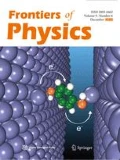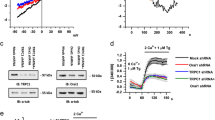Abstract
In neurons of patients with Alzheimer’s disease, the intracellular Ca2+ concentration is increased by its release from the endoplasmic reticulum via the inositol 1, 4, 5-triphosphate receptor (IP3R). In this paper, we discuss the IP3R gating dynamics in familial Alzheimer’s disease (FAD) cells induced with presenilin mutation PS1. By fitting the parameters of an IP3R channel model to experimental data of the open probability, the mean open time and the mean closed time of IP3R channels, in control cells and FAD mutant cells, we suggest that the interaction of presenilin mutation PS1 with IP3R channels leads the decrease in the unbinding rates of IP3 and the activating Ca2+ from IP3Rs. As a result, the increased affinities of IP3 and activating Ca2+ for IP3R channels induce the increase in the Ca2+ signal in FAD mutant cells. Specifically, the PS1 mutation decreases the IP3 dissociation rate of IP3R channels significantly in FAD mutant cells. Our results suggest possible novel targets for FAD therapeutic intervention.
Similar content being viewed by others
References
M. Hutton and J. Hardy, The presenilins and Alzheimer’s disease, Hum. Mol. Genet. 6(10), 1639 (1997)
J. Hardy, A hundred years of Alzheimer’s disease research, Neuron 52(1), 3 (2006)
F. M. LaFerla and S. Oddo, Alzheimer’s disease: Abeta, tau and synaptic dysfunction, Trends Mol. Med. 11(4), 170 (2005)
M. P. Mattson, Pathways towards and away from Alzheimer’s disease, Nature 430(7000), 631 (2004)
C. Haass and D. J. Selkoe, Soluble protein oligomers in neurodegeneration: Lessons from the Alzheimer’s amyloid beta-peptide, Nat. Rev. Mol. Cell Biol. 8(2), 101 (2007)
J. Hardy and D. J. Selkoe, The amyloid hypothesis of Alzheimer’s disease: Progress and problems on the road to therapeutics, Science 297(5580), 353 (2002)
F. M. LaFerla, Calcium dyshomeostasis and intracellular signalling in Alzheimer’s disease, Nat. Rev. Neurosci. 3(11), 862 (2002)
I. F. Smith, K. N. Green, and F. M. LaFerla, Calcium dysregulation in Alzheimer’s disease: Recent advances gained from genetically modified animals, Cell Calcium 38(3–4), 427 (2005)
J. Herms, I. Schneider, I. Dewachter, N. Caluwaerts, H. Kretzschmar, and F. Van Leuven, Capacitive calcium entry is directly attenuated by mutant presenilin-1, independent of the expression of the amyloid precursor protein, J. Biol. Chem. 278(4), 2484 (2003)
M. A. Leissring, B. A. Paul, I. Parker, C. W. Cotman, and F. M. LaFerla, Alzheimer’s presenilin-1 mutation potentiates inositol 1, 4, 5-trisphosphate-mediated calcium signaling in Xenopus oocytes, J. Neurochem. 72(3), 1061 (1999)
I. F. Smith, B. Hitt, K. N. Green, S. Oddo, and F. M. LaFerla, Enhanced caffeine-induced Ca2+ release in the 3xTg-AD mouse model of Alzheimer’s disease, J. Neurochem. 94(6), 1711 (2005)
G. E. Stutzmann, Calcium dysregulation, IP3 signaling, and Alzheimer’s disease, Neuroscientist 11(2), 110 (2005)
G. E. Stutzmann, A. Caccamo, F. M. LaFerla, and I. Parker, Dysregulated IP3 signaling in cortical neurons of knock-in mice expressing an Alzheimer’s-linked mutation in presenilin1 results in exaggerated Ca2+ signals and altered membrane excitability, J. Neurosci. 24(2), 508 (2004)
J. K. Foskett, C. White, K. H. Cheung, and D. O. D. Mak, Inositol trisphosphate receptor Ca2+ release channels, Physiol. Rev. 87(2), 593 (2007)
M. J. Berridge, M. D. Bootman, and H. L. Roderick, Calcium signaling: Dynamics, homeostasis and remodeling, Nat. Rev. Mol. Cell Biol. 4(7), 517 (2003)
K. N. Green, A. Demuro, Y. Akbari, B. D. Hitt, I. F. Smith, I. Parker, and F. M. LaFerla, SERCA pump activity is physiologically regulated by presenilin and regulates amyloid beta production, J. Cell Biol. 181(7), 1107 (2008)
S. Chakroborty, I. Goussakov, M. B. Miller, and G. E. Stutzmann, Deviant ryanodine receptor-mediated calcium release resets synaptic homeostasis in presymptomatic 3xTg-AD mice, J. Neurosci. 29(30), 9458 (2009)
G. E. Stutzmann, I. Smith, A. Caccamo, S. Oddo, F. M. Laferla, and I. Parker, Enhanced ryanodine receptor recruitment contributes to Ca2+ disruptions in young, adult, and aged Alzheimer’s disease mice, J. Neurosci. 26(19), 5180 (2006)
H. Qi and J. Shuai, Alzheimer’s disease via enhanced calcium signaling caused by the decrease of endoplasmic reticulum–mitochondrial distance, Med. Hypotheses. 89, 28 (2016)
H. Qi, L. Li, and J. Shuai, Optimal microdomain crosstalk between endoplasmic reticulum and mitochondria for Ca2+ oscillations, Sci. Rep. 5, 7984 (2015)
N. Hirashima, R. Etcheberrigaray, S. Bergamaschi, M. Racchi, F. Battaini, G. Binetti, S. Govoni, and D. L. Alkon, Calcium responses in human fibroblasts: a diagnostic molecular profile for Alzheimer’s disease, Neurobiol. Aging. 17(4), 549 (1996)
E. Ito, K. Oka, R. Etcheberrigaray, T. J. Nelson, D. L. McPhie, B. Tofel-Grehl, G. E. Gibson, and D. L. Alkon, Internal Ca2+ mobilization is altered in fibroblasts from patients with Alzheimer disease, Proc. Natl. Acad. Sci. USA 91(2), 534 (1994)
K. H. Cheung, D. Shineman, M. Muller, C. Cardenas, L. Mei, J. Yang, T. Tomita, T. Iwatsubo, V. M. Lee, and J. K. Foskett, Mechanism of Ca2+ disruption in Alzheimer’s disease by presenilin regulation of InsP3 receptor channel gating, Neuron. 58(6), 871 (2008)
K. H. Cheung, L. Mei, D. O. D. Mak, I. Hayashi, T. Iwatsubo, D. E. Kang, and J. K. Foskett, Gain-offunction enhancement of InsP3 receptor modal gating by familial Alzheimer’s disease-linked presenilin mutants in humancells and mouse neurons, Sci. Signal. 3(114), ra22 (2010)
G. W. De Young, and J. Keizer, A single-pool inositol 1, 4, 5-trisphosphate-receptor-based model for agonist-stimulated oscillations in Ca2+ concentration, Proc. Natl. Acad. Sci. USA 89(20), 9895 (1992)
J. Sneyd and J. Dufour, A dynamic model of the type-2 inositol trisphosphate receptor, Proc. Natl. Acad. Sci. USA 99(4), 2398 (2002)
D. O. D. Mak, S. M. J. McBride, and J. K. Foskett, Spontaneous channel activity of the inositol 1, 4, 5- trisphosphate (InsP3) receptor (InsP3R): Application of allosteric modeling to calcium and InsP3 regulation of InsP3R single-channel gating, J. Gen. Physiol. 122(5), 583 (2003)
J. Shuai, J. E. Pearson, J. K. Foskett, D. O. D. Mak, and I. Parker, A kinetic model of single and clustered IP3 receptors in the absence of Ca2+ feedback, Biophys. J. 93(4), 1151 (2007)
J. W. Shuai, D. P. Yang, J. E. Pearson, and S. Rüdiger, An investigation of models of the IP3R channel in Xenopus oocyte, Chaos 19(3), 037105 (2009)
G. Ullah, D. O. Daniel Mak, and J. E. Pearson, A datadriven model of a modal gated ion channel: The inositol 1, 4, 5-trisphosphate receptor in insect Sf9 cells, J. Gen. Physiol. 140(2), 159 (2012)
B. A. Bicknell, and G. J. Goodhill, Emergence of ion channel modal gating from independent subunit kinetics, Proc. Natl. Acad. Sci. USA 113(36), E5288 (2016)
L. Ionescu, C. White, K. H. Cheung, J. Shuai, I. Parker, J. E. Pearson, J. K. Foskett, and D. O. D. Mak, Mode switching is the major mechanism of ligand regulation of InsP3 receptor calcium release channels, J. Gen. Physiol. 130(6), 631 (2007)
D. O. D. Mak, J. E. Pearson, K. P. C. Loong, S. Datta, M. Fernández-Mongil, and J. K. Foskett, Rapid ligand-regulated gating kinetics of single inositol 1, 4, 5-trisphosphate receptor Ca2+ release channels, EMBO Rep. 8(11), 1044 (2007)
G. Ullah, A. Demuro, I. Parker, and J. E. Pearson, Analyzing and modeling the kinetics of amyloid beta pores associated with Alzheimer’s disease pathology, PLoS One 10(9), e0137357 (2015)
Acknowledgements
We acknowledge support from the National Natural Science Foundation of China (Grant Nos. 31370830 and 11675134), the 111 Project (Grant No. B16029), and the China Postdoctoral Science Foundation (Grant No. 2016M602071).
Author information
Authors and Affiliations
Corresponding author
Additional information
Special Topic: Soft-Matter Physics and Complex Systems (Ed. Zhi-Gang Zheng).
Rights and permissions
About this article
Cite this article
Wei, F., Li, X., Cai, M. et al. Regulation of 1, 4, 5-triphosphate receptor channel gating dynamics by mutant presenilin in Alzheimer’s disease cells. Front. Phys. 12, 128702 (2017). https://doi.org/10.1007/s11467-017-0670-1
Received:
Accepted:
Published:
DOI: https://doi.org/10.1007/s11467-017-0670-1




